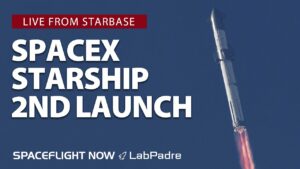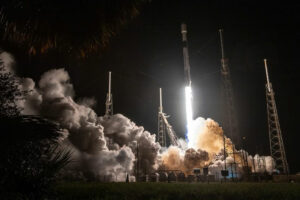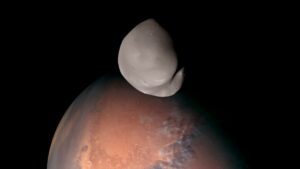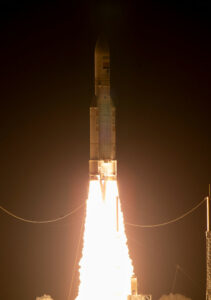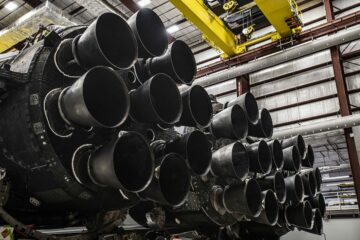
A Falcon 9 rocket launched from Cape Canaveral early Sunday with a high-power digital radio satellite for SiriusXM, marking SpaceX’s 18th Falcon 9 flight since Jan. 1, but just the third dedicated to external commercial customers in a year dominated by missions building out the company’s own Starlink internet network.
It was the eighth Falcon 9 launch in the last 44 days. The busy stretch of SpaceX missions since Jan. 1 has been dominated by launches deploying the company’s own Starlink internet satellites.
So far this year, SpaceX is on a pace to break the annual record for the most orbital flights by any U.S. launch provider, but the SXM 8 mission was just SpaceX’s third flight of 2021 to devoted to deploying commercial payloads from other companies.
The Turkish Turksat 5A satellite launched Jan. 7 on SpaceX’s first mission of the year, and a Falcon 9 rideshare mission Jan. 24 carried 143 small satellites into orbit. Most of the 143 spacecraft came from commercial satellite operators.
Thirteen Falcon 9 missions this year have launched Starlink internet satellites as primary payloads. The missions completed the first stage of deployment of SpaceX’s global broadband network, giving the company more than 1,600 active satellites, more than any other operator.
SpaceX has also launched two Falcon 9 rockets under contract to NASA, including an April 23 launch that ferried four astronauts to the International Space Station. Another Falcon 9 took off Thursday with a Dragon cargo capsule hauling supplies and experiments to the space station.
The SXM 8 radio broadcasting satellite was also just the second geostationary communications payload launched by SpaceX year. Once dominated by heavy communications platforms, the commercial satellite and launch markets are shifting to servicing fleets of numerous smaller spacecraft, like the Starlink constellation.
Powered by nine Merlin main engines, the 229-foot-tall (70-meter) Falcon 9 rocket and the SXM 8 spacecraft climbed through an overcast sky after lifting off at 12:26 a.m. EDT (0426 GMT) Sunday from pad 40 at Cape Canaveral Space Force Station in Florida.
Liftoff of SpaceX’s Falcon 9 rocket on a mission to replenish SiriusXM’s satellite radio network. https://t.co/EgKWgezxwK pic.twitter.com/cU4mvWZQSk
- اب اسپیس لائٹ (@ اسپیس فلائٹ اب) جون 6، 2021
The Falcon 9 steered east from Florida’s Space Coast on a trajectory to boost SiriusXM’s SXM 8 radio broadcasting satellite toward its operational equatorial orbit.
The first stage’s Merlin 1D engines shut down about two-and-a-half minutes after liftoff. The booster separated from the Falcon 9’s upper stage a few seconds later.
While the second stage’s single Merlin engine accelerated the SXM 8 satellite into orbit, the 15-story booster stage nailed its landing on a SpaceX drone ship in the Atlantic Ocean after a supersonic descent back through the atmosphere.
The first stage’s successful landing ended the booster’s third mission to space and back, following launches last November and in April, each carrying astronauts aboard SpaceX Crew Dragon spaceships heading to the International Space Station.
The Falcon 9’s second stage reignited about 26 minutes into the mission to propel the SXM 8 satellite into an elongated transfer orbit stretching to an apogee, or high point, more than 12,000 miles (about 20,000 kilometers) above Earth.
The mission concluded with an on-target deployment of the SXM 8 satellite nearly 32 minutes after liftoff. Video from a camera on-board the Falcon 9 rocket showed the roughly 7.5-ton (nearly 7-metric ton)spacecraft, built by Maxar Technologies, separating in sunlight over Africa.
SXM 8 separation confirmed.
SiriusXM’s new satellite — built by Maxar with a fueled mass of nearly 7 metric tons — deployed from SpaceX’s Falcon 9 rocket to begin a mission beaming radio programming across the United States, Canada, and the Caribbean.https://t.co/EgKWgezxwK pic.twitter.com/ppHls7eBVq
- اب اسپیس لائٹ (@ اسپیس فلائٹ اب) جون 6، 2021
The 27-foot-tall (8-meter) satellite is expected to unfurl solar panels and fire its own engine to circularize its orbit at geostationary altitude more than 22,000 miles (nearly 36,000 kilometers) over the equator in the next few weeks. The spacecraft will undergo testing before commencing commercial service for SiriusXM.
SXM 8 دو سیٹلائٹ آرڈر میں دوسرا خلائی جہاز ہے جسے SiriusXM نے 2016 میں رکھا تھا۔ پہلا سیٹلائٹ، SXM 7، گزشتہ دسمبر میں Falcon 9 راکٹ پر کامیابی کے ساتھ لانچ کیا گیا تھا لیکن سروس میں داخل ہونے سے پہلے اسے پے لوڈ میں ناکامی کا سامنا کرنا پڑا تھا۔
SiriusXM confirmed the failure of “certain SXM 7 payload units” in January, following orbit-raising maneuvers to reach geostationary orbit.
اپریل میں سہ ماہی آمدنی کی رپورٹ میں، SiriusXM نے کہا کہ اس نے سیٹلائٹ کو مکمل نقصان کا اعلان کرنے کے بعد SXM 220 مشن کی ناکامی سے $7 ملین کی خرابی کا چارج ریکارڈ کیا۔ SiriusXM نے کہا کہ اس کے پاس $225 ملین انشورنس ہے جس میں SXM 7 سیٹلائٹ کے اندرون مدار آپریشنز کے پہلے سال کا احاطہ کیا گیا ہے، اور کمپنی نے کہا کہ وہ پالیسی کے تحت دعوی دائر کرنے کی توقع رکھتی ہے۔
SiriusXM کے ایگزیکٹو نائب صدر اور چیف فنانشل آفیسر شان سلیوان نے کہا کہ کمپنی نے سیٹلائٹ مینوفیکچررز کو SXM 7 کا متبادل بنانے کے لیے تجاویز کی درخواست جاری کی ہے۔
میکسار نے مئی میں کہا کہ SXM 7 کی ناکامی نے اس کے مالیاتی بیان پر 28 ملین ڈالر کا اثر درج کیا، جس میں SiriusXM سے 25 ملین ڈالر کی گمشدہ ادائیگیاں بھی شامل ہیں جو کہ اگر خلائی جہاز کامیابی کے ساتھ کام شروع کر دیتا ہے۔ میکسار نے سیٹلائٹ کی مرمت اور بازیافت کرنے کی کوشش میں مزید 3 ملین ڈالر خرچ کیے۔
SiriusXM نے کہا کہ اسے توقع نہیں ہے کہ اس کی سیٹلائٹ ریڈیو سروس SXM 7 کی ناکامی سے متاثر ہوگی۔
حکام نے پچھلے سال کہا تھا کہ SXM 7 سے XM 3 ریڈیو براڈکاسٹنگ سیٹلائٹ کو 85 ڈگری مغربی طول البلد پر تبدیل کرنے کی توقع تھی۔ بوئنگ کا بنایا ہوا XM 3 سیٹلائٹ 2005 میں لانچ کیا گیا۔ سی لانچ Zenit 3SL راکٹ پر سوار۔
SiriusXM نے کہا کہ اس کے XM 3 اور XM 4 سیٹلائٹس جیو سنکرونس مدار میں کام کرتے رہتے ہیں اور کئی سالوں تک ریڈیو براڈکاسٹ سروسز فراہم کرنا جاری رکھ سکتے ہیں۔ ایک اور سیٹلائٹ، XM 5، مدار میں اسپیئر کے طور پر دستیاب ہے۔

SXM 8 اصل میں XM 4 کو تبدیل کرنے والا تھا، لیکن SiriusXM نے اس بات کی تصدیق نہیں کی ہے کہ آیا اس نے SXM 7 کی ناکامی کے بعد سیٹلائٹ کی تعیناتی کے منصوبے کو تبدیل کیا ہے۔ حکام نے یہ بھی نہیں بتایا کہ اگر کوئی ہے تو، Maxar نے SXM 8 میں کیا تبدیلیاں کی ہیں تاکہ اس کے خطرے کو ختم کیا جا سکے۔ اسی طرح کی ناکامی جس نے SXM 7 کو نشانہ بنایا۔
میکسار کے 1300-سیریز کے خلائی جہاز کے ڈیزائن کی بنیاد پر، SXM 7 اور SXM 8 سیٹلائٹس میں بڑے قابل تعینات S-band اینٹینا ہیں جو L3Harris نے SiriusXM کے صارفین کو ریڈیو سگنل نشر کرنے کے لیے بنائے ہیں۔ زمین پر چھوٹے ٹرمینلز، جیسے کاروں پر سیٹلائٹ ریڈیو ریسیورز والے صارفین کو ہائی پاور سگنل بیم کرنے کے لیے سیٹلائٹ کے لیے ایس بینڈ ریفلیکٹر کی ضرورت ہوتی ہے۔
"Maxar اور SiriusXM کا دہائیوں پرانا رشتہ ہے، اور ہم نویں سیٹلائٹ کی فراہمی کے لیے پرجوش ہیں جو ہم نے 2000 سے ان کے لیے بنایا ہے،" پال ایسٹی، میکسار کے خلائی پروگراموں کی ترسیل کے ایگزیکٹو نائب صدر نے کہا۔ "SXM-8، جو میکسار کی ثابت شدہ 1300 کلاس بس پر بنایا گیا ہے، میکسار کی طرف سے تعمیر کردہ پہلی نسل کے SiriusXM نکشتر سے دوگنا بڑا اور طاقتور ہے۔"
SpaceX’s next launch is scheduled for June 17 from Cape Canaveral with the U.S. Space Force’s next GPS navigation satellite.
دوستوں کوارسال کریں مصنف.
ٹویٹر پر اسٹیفن کلارک کو فالو کریں: @StephenClark1.
- "
- 000
- 2016
- 2021
- 7
- 9
- فعال
- افریقہ
- اینٹینا
- اپریل
- بیم
- براڈبینڈ
- تعمیر
- عمارت
- بس
- کینیڈا
- چارج
- لے جانے والا۔
- کاریں
- چارج
- چیف
- چیف فنانشل آفیسر
- تجارتی
- کموینیکیشن
- کمپنیاں
- کمپنی کے
- جاری
- کنٹریکٹ
- کریڈٹ
- گاہکوں
- ترسیل
- ڈیزائن
- ڈیجیٹل
- ڈریگن
- ڈرون
- ابتدائی
- آمدنی
- ایگزیکٹو
- امید ہے
- فیس بک
- ناکامی
- باہمی
- فالکن 9
- مالی
- آگ
- پہلا
- پرواز
- پروازیں
- فلوریڈا
- دے
- گلوبل
- گوگل
- GPS
- ہائی
- HTTPS
- اثر
- سمیت
- انشورنس
- بین الاقوامی سطح پر
- بین الاقوامی خلائی سٹیشن
- انٹرنیٹ
- IT
- بڑے
- شروع
- آغاز
- Markets
- مرلن
- دس لاکھ
- مشن
- ناسا
- سمت شناسی
- نیٹ ورک
- سمندر
- افسر
- آپریشنز
- حکم
- دیگر
- ادائیگی
- پلیٹ فارم
- پالیسی
- صدر
- پروگرامنگ
- پروگرام
- ریڈیو
- بازیافت
- رپورٹ
- رسک
- سیٹلائٹ
- مصنوعی سیارہ
- سمندر
- سروسز
- سیکنڈ اور
- چھوٹے
- شمسی
- شمسی پینل
- خلا
- خلائی قوت
- خلائی سٹیشن
- خلائی جہاز
- خلائی پرواز
- SpaceX
- اسٹیج
- بیان
- امریکہ
- کامیاب
- سورج کی روشنی
- ٹیکنالوجی
- ٹیسٹنگ
- اوپر
- ٹن
- پیغامات
- ٹویٹر
- ہمیں
- متحدہ
- ریاست ہائے متحدہ امریکہ
- صارفین
- نائب صدر
- ویڈیو
- مغربی
- سال
- سال




